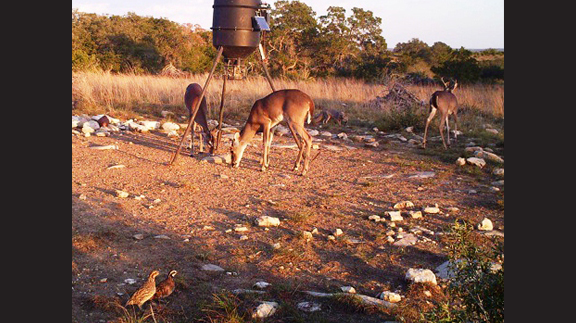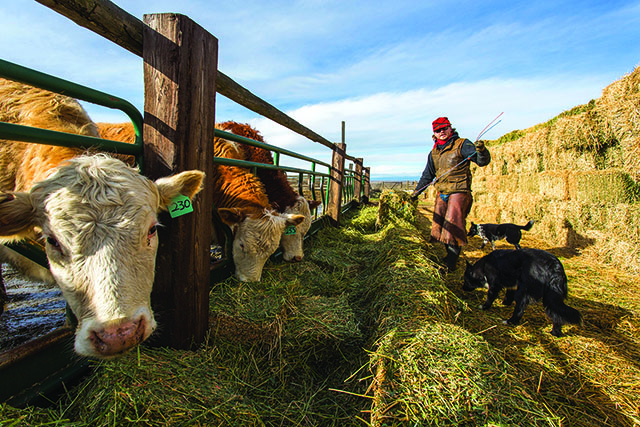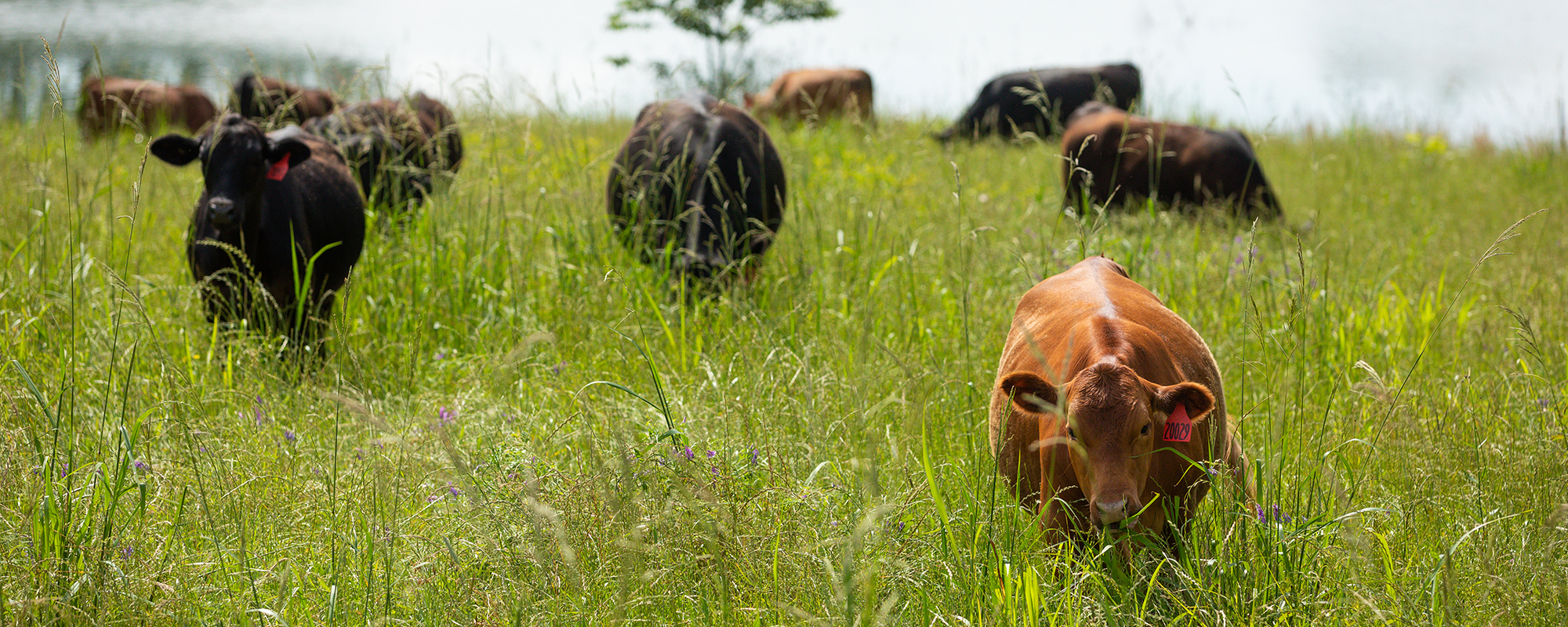HOME
AgriLife Research investigators study effects of aflatoxins on quail reproduction

By: Paul Schattenberg
UVALDE – In an effort to discover find what’s causing the decline of Texas wild quail populations, Texas A&M AgriLife Research scientists investigated whether regular ingestion of low levels of aflatoxins by bobwhite and scaled quail may impacttheir ability to reproduce.
VIDEO: Quail and Afaltoxin Study: https://youtu.be/KV1r1ZONWDE
“In trying to identify reasons behind the decline in quail populations in Texas, we determined it would be worthwhile to study whether aflatoxins, which are fungal toxins that contaminate grain, might be a concern,” said Dr. Susan Cooper, AgriLife Research wildlife ecologist at the Texas A&M AgriLife Research and Extension Center in Uvalde.
“We wondered whether eating grain-based feed supplements for wildlife, especially deer corn, might possibly expose quail to chronic low levels of aflatoxin poisoning, thereby affecting their reproductive ability.”
Cooper was helped in the study by research assistant Shane Sieckenius and research technician Andrea Silva, both of AgriLife Research in Uvalde.
Cooper said previous research has shown acute dosages of 100 parts per billion of aflatoxin in poultry could cause liver damage or dysfunction, leading to ill health as well as reduced egg production and hatchability.
In wild quail, such effects would result in a decrease in reproductive output and reduction in quail population, she said.
“We knew that experimental doses of even small amounts of aflatoxins may cause liver damage and immunosuppression,” Cooper explained. “So the objective of this study was to determine whether consumption of aflatoxins in feed at those levels likely to be encountered as a result of wild quail eating supplemental feed provided for quail, deer or livestock, would result in a reduction in their reproductive output.”
The researchers conducted feeding trials using 30 northern bobwhites and 30 scaled quail housed in breeding pairs. They initially conducted free-choice trials on three replicate pairs of each type of quail to determine if they could detect the presence of aflatoxin in their feed. The birds could not detect and avoid aflatoxins.
Then for 25 weeks, encompassing the breeding season of March through August, the researchers divided the remaining quail into four groups of three pairs of each species. These 12 pairs of caged northern bobwhites and 12 pairs of scaled quail were fed diets that included twice weekly feedings of 20 grams of corn. The corn had either 0, 25, 50 or 100 parts per billion of aflatoxin B1 added to it prior to consumption by the quail.
“These amounts of aflatoxin — 25, 50 and 100 parts per billion — represented the recommended maximum levels for bird feed and legal limits for wildlife and livestock feed respectively,” Cooper said. “And the feeding schedule mimicked what would occur with wild quail periodically visiting a source of supplemental feed.”

Quail were weighed monthly to see if there was any weight change due to the consumption of grain-based feed with low-level amounts of aflatoxion. (Texas A&M AgriLife Research photo)
The researchers measured any changes in reproductive output and quail health over the six-month breeding period. Reproductive output was measured in terms of number of eggs produced per week as well as the weight of the eggs and their yolks. Health changes were measured by the amount of food consumed by the quail on a weekly basis and by any reduction in weight as measured on a monthly basis.
“We had to extract the birds from the pens using butterfly nets, then put them into a small enclosed cage area to weigh them,” said Sieckenius, who also prepared the corn for adding the aflatoxin. “We collected eggs daily and hard-boiled the eggs collected on the last week of each month to extract the yolks so we could accurately measure their weight.”
Cooper said the results of the study showed intermittent consumption of aflatoxin-contaminated feed had no measurable effect on the body weight, feed consumption and visible health of either species of quail.
“The reproductive output, measured by number of eggs produced, egg weight and yolk weight, was also unaffected,” she said. “Thus, in the short term, it appears that chronic low-level exposure to aflatoxins has no measurable deleterious effects on the health and productivity of quail.”
Cooper said as a result of the study it was possible to conclude that aflatoxins in supplemental feed are unlikely to be a factor contributing to the long-term population decline of northern bobwhite and scaled quail through reduced health or egg production. However, she cautioned that feed should be kept dry to avoid potential contamination with higher levels of aflatoxin that may be harmful.
”This project also does not address any long-term effects of aflatoxin consumption that may become evident when wild quail are exposed to nutritional or environmental stresses,” she said.
-30-
LikeTweet
Find more stories, photos, videos and audio at http://today.agrilife.org
HOME
Farm and Ranch Injuries

By Barry Whitworth, DVM
In January, I attended the Oklahoma Veterinary Conference. While waiting for one of the sessions to start, a classmate of mine commented how many of the attendees walk with a limp, used a cane, and/or have damaged hands. We all agreed that working with animals is hard on the body. In general, anything associated with farming and ranching is dangerous.
Most farmers and ranchers know that agriculture is a dangerous occupation. According to United States Bureau of Statistics, workers involved in agriculture, forestry, and fishing had the highest occupational fatality rate in 2022. The fatality rate of 23.5 per 100,000 full-time equivalent (FTE) workers for this group is much higher when compared to the overall occupation fatality rate of 3.7 per 100,000 FTE. Most of the agriculture-related fatalities are associated with transportation, such as tractor overturns, and vehicle crashes, but a fair number involve livestock.
To read more, pick up a copy of the March issue of NTFR magazine. To subscribe by mail, call 940-872-5922.
HOME
Jesses Jewelz

By Jesse Kader
Comfy and keep it western. That’s the name of the game this month. It’s hot and who wants clingy clothing? This jumpsuit is perfectly comfortable and relaxed without forfeiting the fashion. Dress it up or keep it casual. See this and more at www.jessesjewelz.com.
HOME
Noble Research Institute Expands New Program Offering Farmers and Ranchers the Essentials of Regenerative Ranch Management

The educational program has been expanded to three new locations, empowering ranchers and farmers to monitor and improve the health of their land, livestock and livelihood through regenerative principles.
ARDMORE, OK–September 12, 2023 – Noble Research Institute announced the expansion of Essentials of Regenerative Ranching, a new educational program designed to help ranchers enhance and restore the land, making it more resilient and reaching livestock grazing goals through regenerative management. Essentials of Regenerative Ranching provides producers with practical tools, hands-on experience and guidance to make data-driven decisions to decrease costs and improve profit.
The Essentials of Regenerative Ranching course has been expanded to three new locations in Texas and Oklahoma. Registration is open now at www.noble.org/essentials. Seating is limited, so early registration is recommended.
Texas A&M
College Station, Texas
October 17 – 18
O.D. Butler, Jr. Animal Science Complex
Noble Research Institute
Ardmore, Oklahoma
October 31 – November 1
Pavilion Center
Texas A&M
Kingsville, Texas
November 7-8
Caesar Kleberg Wildlife Center
“Program participants gain working knowledge and experience of monitoring and improving the health of their soil, grazing livestock more strategically and making informed financial decisions,” said Hugh Aljoe, Noble Research Institute’s director of ranches, outreach and partnerships. “We use a mix of classroom and field work to send producers home with the tools they need to begin making changes on their ranch.”
Farmers and ranchers navigate uncertainty from weather, fluctuating market prices and escalating costs of inputs. Many producers are seeking new tools that offer greater control and reduce their operational uncertainty. Through this course, ranchers and farmers will calculate their financial situations, determine initial stocking rates, carrying capacity and grazing goals.
“The course is well-suited for ranchers of all experience levels and all types and sizes of operations,” Aljoe added. “No matter your situation, this program will transform the way you think about your ranch.”
The Essentials of Regenerative Ranching program allows producers to overcome obstacles, become more informed problem-solvers and increase the productivity of their grazing lands. By participating in this program, ranchers join a community of like-minded producers who are shaping the future of ranching and leaving a lasting impact on their land and families. “If I had known what I learned in this course when I started my regenerative journey, I could have avoided some key mistakes,” said Tana McCarter, a rancher, and Essentials attendee. “I left with the tools I needed to monitor my soil health and financial progress. I’ll now have the right data to make informed decisions on how to meet my regenerative goals.”
Noble Research Institute is an independent nonprofit agricultural research organization dedicated to guiding farmers and ranchers in applying regenerative principles that yield healthier soil, more productive grazing land, and business success.
At Noble, researchers, facilitators and ranch staff work together to share with farmers and ranchers the skills and tools to regenerate the land in a profitable manner. Noble is focused on the regenerative management of the nation’s grazing acres, which directly impacts pasture and range environments, wildlife, pecan production, and livestock production. Regenerative management recognizes that each decision made on the ranch impacts the interactions of the soil, plants, water, animals, economics and people. Noble’s 14,000 acres of working ranch lands provide a living laboratory on which to demonstrate and practice regenerative principles and ideas to deliver value to farmers and ranchers across the U.S.
-

 Country Lifestyles1 year ago
Country Lifestyles1 year agoScott & Stacey Schumacher: A Growth Mindset
-

 Equine7 months ago
Equine7 months agoThe Will to Win
-

 Country Lifestyles7 years ago
Country Lifestyles7 years agoStyle Your Profile – What your style cowboy hat says about you and new trends in 2017
-

 Country Lifestyles4 years ago
Country Lifestyles4 years agoAmber Crawford, Breakaway Roper
-

 HOME7 years ago
HOME7 years agoGrazing North Texas – Wilman Lovegrass
-

 Country Lifestyles7 years ago
Country Lifestyles7 years agoDecember 2016 Profile, Rusty Riddle – The Riddle Way
-

 Outdoor9 years ago
Outdoor9 years agoButtercup or Primrose?
-

 Country Lifestyles8 years ago
Country Lifestyles8 years agoJune 2016 Profile – The man behind the mic: Bob Tallman






